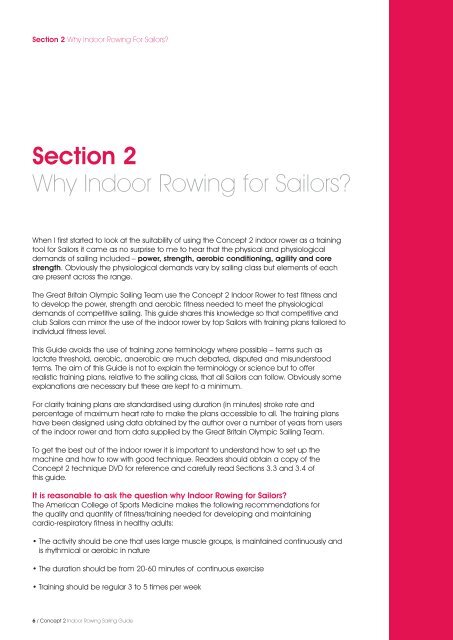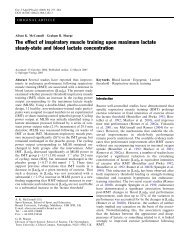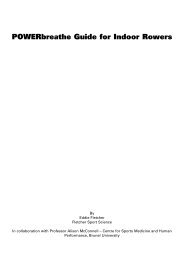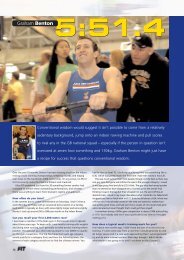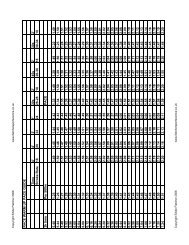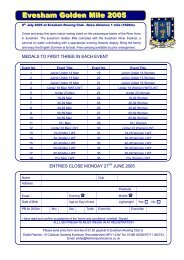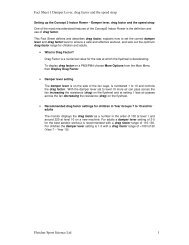Concept2-Sailing Rowing Guide.indd - Fletcher Sport Science
Concept2-Sailing Rowing Guide.indd - Fletcher Sport Science
Concept2-Sailing Rowing Guide.indd - Fletcher Sport Science
Create successful ePaper yourself
Turn your PDF publications into a flip-book with our unique Google optimized e-Paper software.
Section 2 Why Indoor <strong>Rowing</strong> For Sailors?<br />
Section 2<br />
Why Indoor <strong>Rowing</strong> for Sailors?<br />
When I first started to look at the suitability of using the Concept 2 indoor rower as a training<br />
tool for Sailors it came as no surprise to me to hear that the physical and physiological<br />
demands of sailing included – power, strength, aerobic conditioning, agility and core<br />
strength. Obviously the physiological demands vary by sailing class but elements of each<br />
are present across the range.<br />
The Great Britain Olympic <strong>Sailing</strong> Team use the Concept 2 Indoor Rower to test fitness and<br />
to develop the power, strength and aerobic fitness needed to meet the physiological<br />
demands of competitive sailing. This guide shares this knowledge so that competitive and<br />
club Sailors can mirror the use of the indoor rower by top Sailors with training plans tailored to<br />
individual fitness level.<br />
This <strong>Guide</strong> avoids the use of training zone terminology where possible – terms such as<br />
lactate threshold, aerobic, anaerobic are much debated, disputed and misunderstood<br />
terms. The aim of this <strong>Guide</strong> is not to explain the terminology or science but to offer<br />
realistic training plans, relative to the sailing class, that all Sailors can follow. Obviously some<br />
explanations are necessary but these are kept to a minimum.<br />
For clarity training plans are standardised using duration (in minutes) stroke rate and<br />
percentage of maximum heart rate to make the plans accessible to all. The training plans<br />
have been designed using data obtained by the author over a number of years from users<br />
of the indoor rower and from data supplied by the Great Britain Olympic <strong>Sailing</strong> Team.<br />
To get the best out of the indoor rower it is important to understand how to set up the<br />
machine and how to row with good technique. Readers should obtain a copy of the<br />
Concept 2 technique DVD for reference and carefully read Sections 3.3 and 3.4 of<br />
this guide.<br />
It is reasonable to ask the question why Indoor <strong>Rowing</strong> for Sailors?<br />
The American College of <strong>Sport</strong>s Medicine makes the following recommendations for<br />
the quality and quantity of fitness/training needed for developing and maintaining<br />
cardio-respiratory fitness in healthy adults:<br />
• The activity should be one that uses large muscle groups, is maintained continuously and<br />
is rhythmical or aerobic in nature<br />
• The duration should be from 20-60 minutes of continuous exercise<br />
• Training should be regular 3 to 5 times per week<br />
6 / Concept 2 Indoor <strong>Rowing</strong> <strong>Sailing</strong> <strong>Guide</strong><br />
Section 2 Why Indoor <strong>Rowing</strong> For Sailors?<br />
• The intensity of the exercise should raise the heart rate to between 60-85%<br />
of maximum heart rate<br />
• Strength training of moderate intensity should be added twice a week<br />
<strong>Rowing</strong> satisfies these recommendations and for Sailors has<br />
a number of advantages over other forms of training:<br />
Photo: Laser <strong>Sailing</strong> © Richard Langdon/Skandia Team GBR<br />
1 <strong>Rowing</strong> is a non-impact exercise; it places less impact-related wear and tear on the<br />
body. This is especially important for combating over- use injuries<br />
2 The rowing machine provides a fitness workout that utilizes every major muscle group in<br />
the body as well as working the heart, lungs and circulatory system through a complete<br />
range of fitness/training intensities and adds variety to your training programme<br />
3 It offers a time-efficient method to improve aerobic capacity and reduce body fat<br />
(Weight is important in some sailing classes e.g. 49er - most boats aim for 148 kg or<br />
155 kg weight band, Laser and Windsurfer classes)<br />
4 It can provide excellent power/strength workouts that will develop the physiological<br />
qualities needed for example, by a 49er crew member when hoisting the spinnaker. This<br />
is a crucial part of a crew’s role and takes approximately 5-7 seconds of flat out effort<br />
5 <strong>Rowing</strong> can be done indoors anytime, important when you are not able to get out sailing<br />
due to inclement weather<br />
6 It is a safe and effective way of training whilst recovering from certain injuries<br />
7 <strong>Rowing</strong> on the <strong>Concept2</strong> Indoor Rower provides an accurate means for monitoring your<br />
level of conditioning, and offers constant feedback whilst rowing. For example, you can<br />
train, using the heart rate monitor interface (Polar PM3/PM4 and/or Suunto on the latest<br />
PM4 monitor) in heart rate training zones that are clearly defined and applicable to you.<br />
Concept 2 Indoor <strong>Rowing</strong> <strong>Sailing</strong> <strong>Guide</strong> / 7


